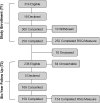Age moderates change in disease-related stress among congenital heart disease survivors: a 6-year follow-up
- PMID: 37163661
- PMCID: PMC10783978
- DOI: 10.1093/eurjcn/zvad045
Age moderates change in disease-related stress among congenital heart disease survivors: a 6-year follow-up
Abstract
Aims: As congenital heart disease (CHD) survivors age, they are confronted with elevated risk of cardiovascular morbidity and increasingly complex disease self-management demands. Given that stress is associated with poor physical and psychosocial outcomes, it is crucial to examine how disease-related stress changes over time in this population. However, this outcome has received little research attention to date. This study aimed to identify demographic and clinical predictors of change in disease-related stress over 6 years among CHD survivors.
Methods and results: Congenital heart disease survivors (N = 252, Mage = 25.6 ± 7.1, 52.9% female) completed the first 13 items of the Responses to Stress Questionnaire, adapted for use among CHD survivors, to assess disease-related stressors at study entry (T1) and 6-year follow-up (T2). Age, gender, estimated family income, and New York Heart Association (NYHA) functional class at T1 were entered into mixed linear models to determine their impact on change in disease-related stress. Older age (P < 0.001), lower income (P < 0.001), and presence of functional limitations (NYHA ≥ II) (P < 0.001) predicted greater increases in disease-related stress. When controlling for NYHA, functional class, and income, a significant time by age interaction was identified such that disease-related stress increased over time among those who were adolescents at T1 [b = 4.20, P = 0.010, 95% confidence interval (1.01, 7.40)], but remained stable among young adults.
Conclusion: The transition from adolescence to adulthood may be a period of increasing disease-related stress. Healthcare providers should consider screening adolescents for elevated disease-related stress during transition education and provide resources to bolster resilience.
Keywords: Adolescents; Adults; Cohort study; Congenital heart disease; Patient-reported outcomes; Stress.
© The Author(s) 2023. Published by Oxford University Press on behalf of the European Society of Cardiology. All rights reserved. For permissions, please e-mail: journals.permissions@oup.com.
Conflict of interest statement
Conflict of interest: None declared.
Figures
References
-
- Marelli AJ, Ionescu-Ittu R, Mackie AS, Guo L, Dendukuri N, Kaouache M. Lifetime prevalence of congenital heart disease in the general population from 2000 to 2010. Circulation 2014;130:749–756. - PubMed
-
- Marelli AJ, Mackie AS, Ionescu-Ittu R, Rahme E, Pilote L. Congenital heart disease in the general population: changing prevalence and age distribution. Circulation 2007;115:163–172. - PubMed
-
- O’Leary JM, Siddiqi OK, de Ferranti S, Landzberg MJ, Opotowsky AR. The changing demographics of congenital heart disease hospitalizations in the United States, 1998 through 2010. JAMA 2013;309:984–986. - PubMed
-
- Kovacs AH, Utens EM. More than just the heart: transition and psychosocial issues in adult congenital heart disease. Cardiol Clin 2015;33:625–634. - PubMed
-
- Westhoff-Bleck M, Briest J, Fraccarollo D, Hilfiker-Kleiner D, Winter L, Maske U, et al. . Mental disorders in adults with congenital heart disease: unmet needs and impact on quality of life. J Affect Disord 2016;204:180–186. - PubMed
MeSH terms
Grants and funding
LinkOut - more resources
Full Text Sources
Research Materials




